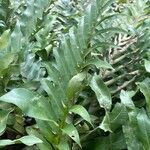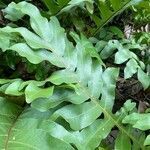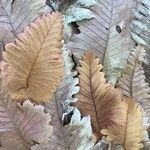Rhizome c. 2 cm or more thick, having a persistently woolly appearance. Scales 2-25 mm long, 0.7-2.5 mm wide, soft, ginger-coloured to dark brown, tapering gradually from the base to the narrow acute apex; margins paler, bearing fine hair-like teeth. Nest fronds ±ovate, 5.5-40 cm long, 9-25.5 cm wide, shallowly to ±deeply lobed; lobes rounded. Foliage fronds commonly from 28 cm to over 1 m long; stipes (0-) 1-7.5 cm long, winged almost to the base. Lamina deeply pinnatifid, coriaceous, pale to mid-green in life; lobes strap-like, narrowed slightly towards the base, tapering to an acute or obtuse apex, 1.5-32 cm long, 1.1-4.9 cm wide. Sori round, 1-2 mm diam., in 2 ±regular rows between adjacent main lateral veins of foliage leaves, not or only slightly impressed into the laminal surface. Spores 37.5-55 µm long, 22.5-37.5 µm wide.
Rhizome shortly creeping, 2-3 cm in diam. or more; scales spreading, blackish brown, linear, 6-20 × 0.5-1 mm, pseudopeltate or peltate, toward apex strongly dentate, apex long, narrow, acute; fronds dimorphic; basal fronds sessile, 15-50 × 10-30 cm, shallowly lobed; foliage fronds stalked, stipe up to 30 cm, not or inconspicuously winged; lamina pinnatifid up to 2-5 mm from costa, 40-100 × ca. 40 cm, apex aborted; pinnae broadly lanceolate, 15-25 × 2-3.5 cm, apex acute or acuminate. Sori in 2 rows between costa and margin, regular or irregular in 2 rows between lateral veins, slightly sunken. Spores with acuminate spines.
A large fern which grows attached to other plants. It climbs on trees. It can be 1 m high. It forms large spreading clumps. The rootstock is thick and fleshy. There are two kinds of fronds. One forms the "nest" and these do not have a stem and the others which are more like leaves and have a stem. The second ones have stems which are 30 cm long. The frond is one m long by 40 cm wide. It has deep lobes. The first kind of fronds have lobes and teeth around the edge. These turn brown with age but do not fall off the fern. The young fronds of this fern are different shape from the mature fronds on established ferns.



